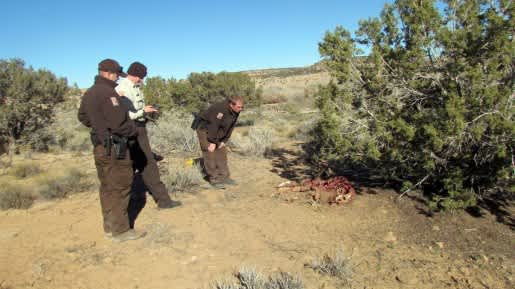Utah DWR Launches Massive Patrol Effort for 2012
Utah Division of Wildlife Resources 11.29.12

If you’re a poacher, you should think twice before killing a mule deer in Utah this winter.
The second winter of Utah’s winter range patrol effort is underway. Conservation officers with the Division of Wildlife Resources and members of sportsman’s groups are combing winter ranges in Utah, looking for those who are trying to take deer illegally.
“Deer poaching isn’t tolerated in Utah,” says Mike Fowlks, chief of the DWR’s Law Enforcement Section. “We’re pulling out all the stops and using all the means we have to protect Utah’s deer herds.”
The following are among the things the DWR is doing:
- Patrolling winter ranges at night. The DWR is conducting these patrols on land and from the air.
- Conducting saturation patrols that put several DWR officers on the same piece of winter range at the same time.
- Encouraging volunteers from sportsman groups to report suspicious activity to DWR officers.
- Winter range patrols are underway across Utah. The patrols will continue until the deer shed their antlers later this spring.
Fowlks says most of the patrolling is happening in areas where deer are most at risk. “But those aren’t the only areas our officers and volunteers are watching,” Fowlks says. “Far from it. We’re watching winter ranges throughout Utah.”
Turn-In-a-Poacher hotline
As you travel through Utah’s backcountry this winter, Fowlks encourages you to keep your eyes and ears open. “You don’t have to be part of this patrol effort to make a difference,” Fowlks says. “If you see something suspicious, let us know as soon as possible.”
Utah’s Turn-in-a-Poacher hotline is the most efficient way to contact a DWR officer. The UTiP number is 1-800-662-3337.
The hotline is staffed 24 hours a day, seven days a week.
Winter a critical time
Much of the deer poaching that happens in Utah happens in the winter. And for good reason — winter is the time of year when mule deer are concentrated on their lower elevation winter ranges. The bucks are also less wary in the winter because the breeding season is either underway, or it just finished.
Fowlks says poachers usually target the biggest bucks they can find. In addition to stealing these big bucks from legal hunters, taking bucks in January or February can also result in too many deer hunting permits being issued for hunts that fall.
Fowlks says DWR biologists count the number of bucks per 100 does in December.
“In December, the deer are bunched together on lower elevation areas where it’s easier to get an accurate count,” he says. “But if poachers kill bucks after the biologists have counted them, the data that’s used to set permit numbers for hunts the next fall won’t be correct.”
Fowlks says the data will show that the number of bucks in the area is higher than it actually is. “And that can result in too many hunting permits being issued,” he says.
Poachers take a big toll
So far in 2012, wildlife officers have investigated the illegal killing of 107 mule deer in Utah.
Most of the deer were bucks. The antlers on 10 of the bucks were big enough to place the deer in a trophy category. “Hunters would have been thrilled to have taken any of these bucks,” Fowlks says.
The monetary value of the animals to Utah’s citizens is $120,000.

